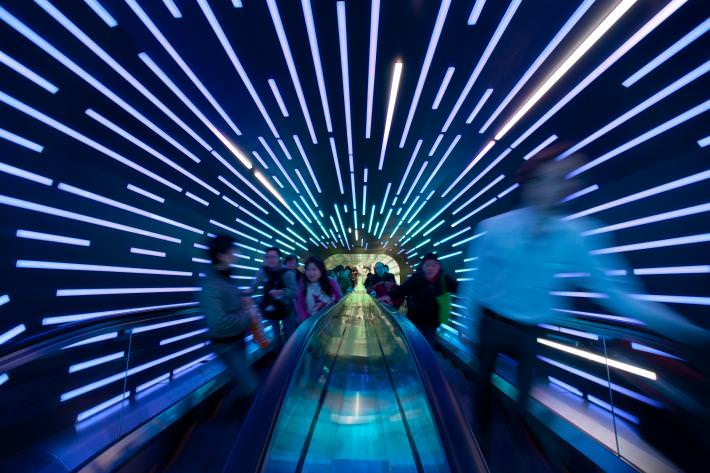Zàijiàn (Goodbye) World Expo!
Posted November 1, 2010
It’s hard to believe, but six months and 73 million visitors later, the 2010 Shanghai World Expo came to a close today, and we are having a tough time saying goodbye to our dream project, the Shanghai Corporate Pavilion (affectionately known as the Dream Cube for being the carrier of people’s dreams for the future of Shanghai).
We braved the sea of last-minute Expo visitors this week to give our last round of tours, attend closing ceremonies and explore what’s next for ESI in China. A testament to our incredible design and production team, including PRG (systems integrator), Spinifex (media production), Full Flood (lighting) and Pico (fabrication), the Dream Cube looked as fresh, and operated as efficiently, as it did when it opened in May. And the message—that a more sustainable future can only be co-created through collective action—is more resonant than ever as it will take a huge collaborative effort to evolve the Expo site after next week.
This Expo is a surreal blend of contradictions. The theme—Better City, Better Life—promoted new models for urban development, yet the event is far from sustainable. It’s massive in scale, but exists for only six months. Nearly all of the 200 pavilions scattered across the five square kilometer site must be taken down before May 2011, except for a few marquee buildings including the China Pavilion and the flying-saucer-shaped Expo Center. Even our beloved Dream Cube (whose structure is comprised of tubes made from recycled CDs), will disappear.
And while Expo rules dictated that the pavilions must be recyclable, the Financial Times reported this week that many pavilions still had not decided on a deconstruction / recycling plan. One happy ending comes from one of my favorite pavilions, the UK’s Seed Cathedral. Shaped like a giant dandelion, the pavilion is formed by 60,000 translucent acrylic rods, each with a seed embedded in its end from the Kew Millennium Seed Bank. The pavilion plans to maintain the dandelion metaphor by showering seed rods on schools throughout China, where they can carry the message of biodiversity throughout the country. Some rods will also be auctioned on Taobao, the online auction site, to raise money for the Shanghai CereCare Wellness Centre, a residential facility offering physiotherapy and education to young children suffering from cerebral palsy.
All of this leaves me thinking that the Expo model is due for some innovation before the next rounds in 2015 (Milan) and 2025 (TBD with recent promos by California Governor Arnold Schwarzenegger for Silicon Alley and Chinese officials for Guangzhou). I love the idea of an Expo being located in a developing country that can use the economic stimulus – but the waste of the current model needs to come to an end. How about picking a city that needs new education, cultural, sports or entertainment facilities and transforming the pavilions into universities, museums, sport arenas or entertainment centers that can provide viable economic development for years after the expo ends? Hopefully a drumbeat will get louder for these massive events (third only to the Olympics and World Cup in terms of audience) to embody more of their message as we hoped to do with the Dream Cube.
So farewell World Expo. We look forward to your continued transformation! In the interim, may the Dream Cube live on through the hearts and minds of the people of Shanghai who helped us create this extraordinary experience by contributing their dreams for the future.



Join The Conversation